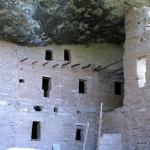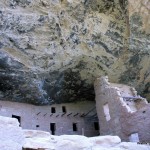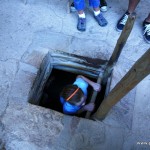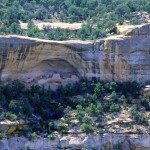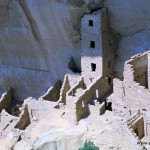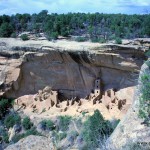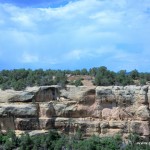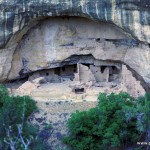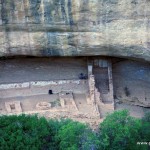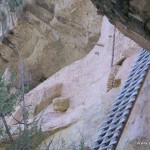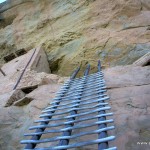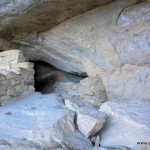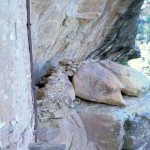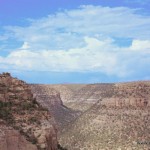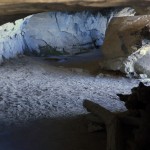Imagine for a moment that you are a cowhand, and that you have been riding in the desert heat for some time in search of missing cattle. Across from the Mesa you are riding upon, you happen to look at the wall of the cliffs below the mesa opposite you.
Your mind drifts for a moment, and you find yourself studying the composition of the opposite mesa’s cliffs; you find yourself paying attention to the layers of clay, limestone, sandstone, shale, and other geologic materials that make up of all the cliff-patterns and colors that you are used to seeing … and suddenly you see something that seems out-of-place. Instead of a colorful rock canyon wall, you see a ruin of what can only be some sort of ancient city built into the arc of a cave.
It’s obvious that a somewhat advanced and social people built these dwellings; there are large common areas, uncovered circular man-made pits, as well as multiple doorways leading into multi-storied rooms; this is no primitive or portable shelter.
The missing cattle are momentarily forgotten … you want to know and understand what you are seeing.
On December 18, 1888, that’s exactly what happened to Richard Wetherill and his brother-in-law, Charles Mason. “They first saw Cliff Palace near modern-day Sun Point and went to investigate. That afternoon Richard entered Spruce Tree House, and the next day the two men climbed to Square Tower House. Although Richard’s brother, Al, [had seen] Cliff Palace the year before, he did not enter the dwelling. So the credit for its “discovery” was given to his brother Richard and to Charles Mason.”
Who lived here? And what happened to them?
About 1,400 years ago, long before Europeans explored North America, a group of people living in the Four Corners region chose Mesa Verde for their home. For more than 700 years they and their descendants lived and flourished here, eventually building elaborate stone communities in the sheltered alcoves of the canyon walls. Then, in the late A.D. 1200s, in the span of a generation or two, they left their homes and moved away.
If you have even the least bit of curiosity about how the earliest Americans lived, then you owe it to yourself to make a trip to Mesa Verde, Colorado. What awaits you is an awe-inspiring trip into the past; you’ll find yourself immersed in a place where multiple generations cohabited together, living off the land, and relying upon skills that they shared with their community for the greater good of their families’ survival.
The Colorado mesa, Mesa Verde, was chosen as the settling point for a group of nomadic people named Anasazi (meaning “Ancient Ones”) by the Navajo, Hisatsinom by the Hopi, and Ancestral Puebloans by the NPS. These Indians occupied the mesa top for approximately 600 years before they began building their most famous remnants: the cliff dwellings.
When you visit Mesa Verde, there are a multitude of cliff houses available to see from the road or to explore in person. We went, and we had time to explore two. The first was the Spruce Tree House, a self-guided tour that we could explore at our own pace, albeit without a park ranger there to answer our questions.
Spruce Tree House, the third largest cliff dwelling (Cliff Palace and Long House are larger), was constructed between A.D. 1211 and 1278 by the ancestors of the Puebloan peoples of the Southwest. The dwelling contains about 130 rooms and 8 kivas (kee-vahs), or ceremonial chambers, built into a natural alcove measuring 216 feet (66 meters) at greatest width and 89 feet (27 meters) at its greatest depth. It is thought to have been home for about 60 to 80 people.
The cliff dwelling was first discovered in 1888, when two local ranchers chanced upon it while searching for stray cattle. A large tree, which they identified as a Douglas Spruce (later called Douglas Fir), was found growing from the front of the dwelling to the mesa top. It is said that the men first entered the dwelling by climbing down this tree, which was later cut down by another early explorer.
One of the cooler features os the Spruce Tree House is that among its eight kivas, or subterranean “pit houses” …
… there is one that you can climb down into and explore.
The reasons are unclear as the Anasazi left no written records; however, it is known that a drought struck the area in 1276 and lasted for 23 years. This drought, in addition to what may have been a depletion of resources after 600 years of occupation, most likely led the people of Mesa Verde to abandon their cliff dwellings.
If you want to see a cliff dwelling with a smaller group of people around while being led by a knowledgeable guide, there are several tours available. We decided to take one so we could explore the Balcony House:
This one-hour, ranger-guided tour involves climbing a 32 ft. ladder, crawling through a 12ft.-long tunnel, and climbing up a 60ft (20m) open rock face with two 10ft (3m) ladders to exit the site. The tour begins at the Balcony House parking area, a 10-mile (16km), 25-minute drive from the Visitor Center.
With 40 rooms, Balcony House is considered a medium size cliff dwelling. Only 10 sites in the park have more. Evidence of how room and passageway construction in the alcove evolved through time can easily be seen in Balcony House. Today, the tunnel, passageways, and modern 32-foot entrance ladder are what make it the most adventurous cliff dwelling tour in the park.
In 1884, a prospector named S.E. Osborn first entered Balcony House, and the house was excavated by Jesse Nubaum in 1910.
Exploring the Balcony House is an adventure, and it is something that must be experienced to completely understand. You will finish the tour with a new appreciation for what men were able to achieve with nothing but stone tools and their own desire to persevere.
There are several other guided tours available at Mesa Verde; so far it has been one of our favorite parts of our cross-country trek. Kev’s girls think the coolest thing about Mesa Verde was being able to look into the kivas themselves, and scrambling through the narrow passageways and climbing the ladder at the Balcony House. I think that my favorite part was having the point made for me (yet again) that it’s not always about how nice your house is or what amenities it offers … sometimes it is all about your home’s location and its view. =)











